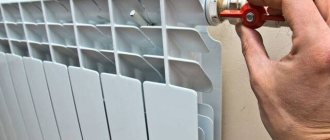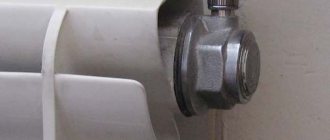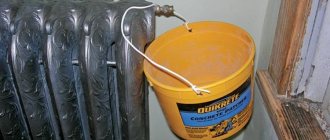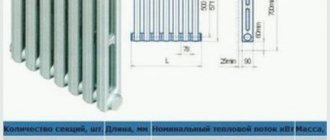Every owner of a private house or apartment with water heating should know how to bleed air from a heating radiator. The thing is that the accumulated air in the radiator becomes an insurmountable obstacle and blocks the flow of coolant.
As a result, the heating radiator ceases to function fully, that is, all or part of its surface ceases to heat up and release heat to the surrounding space.
Airing of the panel heating device (blue color)
To eliminate this phenomenon, you need to bleed the air from the battery. How to do this in a timely and effective manner will be discussed in this article. Carrying out such an operation does not cause any particular difficulties if the heating system is assembled correctly, taking into account all the features of water heating of premises. Throughout the heating season, it is necessary to carry out preventive measures of this nature from time to time.
Causes and signs of air locks in the heating system
The appearance of air pockets inside radiators is primarily associated with the startup of the heating system at the beginning of the heating season and after its overhaul. But practice shows that airing can occur during intensive use of the heating network. There are several reasons for this:
- unplanned repair work (assembly and disassembly) of heating system elements;
- overheating of the coolant, resulting in the release of gases that will air the batteries;
- use of contaminated coolant with air impurities;
- adding additional water to the system;
- connection points of radiator elements and pipelines begin to let water through;
- When installing the heating system, the radiator collectors were not horizontal;
- lack of automatic air bleeding;
- contamination of internal passages in radiators with rust;
- low pressure in hot water pipes.
Signs of airiness may include:
- Tactilely sense cold areas of the battery surface;
- The room temperature drops;
- In autonomous heating systems, an increase in fuel consumption becomes noticeable;
- In the radiators you can hear the coolant gurgling and babbling.
Bleeding air with an automatic air vent
This type of device will function fully automatically. Installation can be carried out on both vertical and horizontal surfaces. In this case, this small device will be responsible for removing air masses from the system. It has a special float that seals the tap, provided that there is enough coolant in the system. When air accumulates, the float will drop and the hole for its release will open slightly.
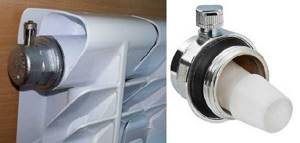
Automatic air vent
However, such a device is not without drawbacks. It is greatly influenced by the quality of the coolant. In this case, the O-ring and water filters must be changed regularly. Valves need to be cleaned regularly. Otherwise, water will leak out of the battery. With proper care, no outside intervention is required.
Dangerous consequences of airy radiators
Accumulation of gases in the heating system leads to the formation of air pockets. The radiators become cold, the pump cannot push the coolant through the air blockages. This can lead to failure of not only the pump, but also the boiler itself. Lack of normal water circulation in the system will cause them to overheat and ultimately break down.
In places where there is small accumulation of air, which does not greatly affect the heating of radiators, pockets of corrosion may occur. Oxygen actively interacts with the metal of the battery, which causes rust and destruction of the wall of the heating device segment.
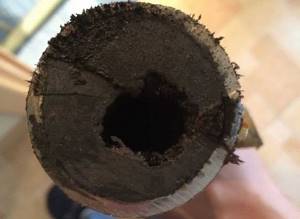
The result of corrosion of the battery collector from air pockets
Uneven heating of the metal causes deformation forces, which negatively affect the tightness of the connections of radiator elements and pipes. As a result, the system will leak and hot water will flow out.
Filling the heating circuit with coolant
In order for the heating system to work correctly, it must be flushed and then refilled with water. It is often at this stage that air leaks into the circuit. This occurs due to incorrect actions while filling the contour. In particular, air can be trapped by too fast a flow of water, as mentioned earlier.
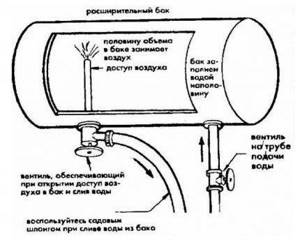
The diagram of the expansion tank of an open heating circuit allows you to get an idea of the procedure for filling such a system with coolant after flushing
In addition, correct filling of the circuit also facilitates faster removal of that part of the air masses that are dissolved in the coolant. To begin with, it makes sense to consider an example of filling an open heating system, at the highest point of which the expansion tank is located.
Such a circuit should be filled with coolant starting from its very bottom. For these purposes, a shut-off valve is installed at the bottom of the system, through which tap water is supplied to the system.
A properly designed expansion tank has a special pipe that protects it from overflow.
A hose of such length should be attached to this pipe that its other end is brought out into the area and is located outside the house. Before you start filling the system, you should take care of the heating boiler. It is recommended to disconnect it from the system at this time so that the protective modules of this unit do not work.
Once these preparatory steps have been completed, you can begin filling the contour. The tap at the bottom of the circuit through which tap water flows is opened so that water fills the pipes very slowly.
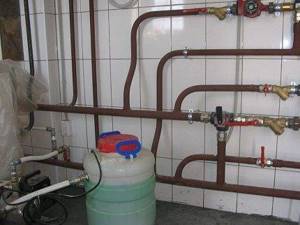
The recommended filling flow rate should be approximately three times less than the maximum possible. This means that the tap should not be turned off completely, but only to one third of the pipe lumen
Slow filling is continued until water flows through the overflow hose leading outside. After this, the water tap should be closed. Now you should go through the entire system and open the Mayevsky valve on each radiator to bleed air.
Then you can reconnect the boiler to the heating system. It is also recommended to open these taps very slowly. While the boiler is filling with coolant, you can hear a hissing sound produced by the air release safety valve.
This is normal. After this, you need to add water to the system again at the same slow pace. The expansion tank should be approximately 60-70% full.
After this, it is necessary to check the operation of the heating system. The boiler is turned on and the heating system is warmed up. Radiators and pipes are then examined to identify areas where heating is missing or insufficient.
Insufficient heating indicates the presence of air in the heating radiators; it must be bled again through the Mayevsky taps. If the procedure for filling the heating circuit with coolant was successful, do not relax.
For at least another week, the operation of the system should be closely monitored, the water level in the expansion tank should be monitored, and the condition of pipes and radiators should be checked. This will allow problems to be quickly resolved.
In a similar way, closed-type systems are filled with coolant. Water should also be supplied to the system at low speed through a special tap.
You can fill a closed-type heating system with working fluid (coolant) on your own
It is important to arm yourself with a pressure gauge for this. But in such systems, pressure control is an important point.
When it reaches a level of two bars, you should turn off the water and bleed air from all radiators through the Mayevsky taps. At the same time, the pressure in the system will begin to decrease. It is necessary to gradually add coolant to the circuit to maintain the pressure at two bar
But in such systems, pressure control is an important point. When it reaches a level of two bars, you should turn off the water and bleed air from all radiators through the Mayevsky taps. At the same time, the pressure in the system will begin to decrease. It is necessary to gradually add coolant to the circuit to maintain the pressure at two bar.
It is difficult to perform both of these operations alone. Therefore, it is recommended to complete the filling of a closed contour together with an assistant. While one person bleeds air from the radiators, his partner monitors the pressure level in the system and immediately corrects it. Collaborative work will improve the quality of this type of work and reduce its time.
When to bleed air from batteries
Any gas is much lighter than water, and therefore, when it enters the radiator, it begins to accumulate at the top point. If the process continues, the air begins to expand and lower the water level. As a result, 50% of the radiator volume or more may remain without water. The heating device practically stops functioning. Therefore, it is necessary to bleed the air from the batteries in any case.
To know when you need to bleed air from a heating radiator in an apartment in a multi-story building, you need to understand when it most often gets there. This occurs under the following circumstances.
- At the end of the heating season in the summer, heating services carry out preventive measures, during which the coolant is drained from the system, both partially and completely. Before the onset of cold weather, new water is poured into the system. Along with it, gas mixtures enter the radiators.
- Owners of private houses often repair their own autonomous heating system in the summer. As a result of inept actions, air enters the heating system.
- In apartment buildings with cast iron radiators, water is specially drained in the summer. This is done to avoid work on replacing gaskets between the registers. If coolant is left in the system, then old radiators may leak at the junctions of sections due to water cooling and pressure drop. When you have to start the heating system again, a large amount of air will enter it.
- During the summer period, the volume of coolant noticeably decreases in volume. When the shut-off valves are opened, due to negative pressure, the water being poured in absorbs gases and fills all risers with them.
What to pay attention to
Each heat exchanger has a release valve, which is usually located in the upper left or upper right corner of the heater. Install the key and turn counterclockwise. You must be slow and careful as there is pressure in the heating system. After a while, a hissing sound may appear. This means that air is being removed from the battery.
Water will start to come out of the heat exchanger, so you must remember to place a container or container underneath it. After a while, only water will come out of the valve. Then it should be turned back clockwise.
Those who have never done this themselves should pay special attention to safety: the water that comes out of the radiator can be very hot at some point. There is even a risk of scalding
How to bleed air from heating radiators in an apartment
Bleed the air from the heating battery, possibly using an air valve. Today there are two ways to release a mixture of gases correctly. This is done using a Mayevsky crane or an automatic air vent. In old cast iron batteries, plugs can only be removed through a regular tap or plugs.
How to remove air from a heating radiator? Bleed the air from the battery! Three different Mayevsky cranes!
Bleeding air in radiators with a Mayevsky valve
In products of the latest generation, namely aluminum, bimetallic, steel and cast iron radiators, manual air vents - Mayevsky taps - are installed to remove air plugs. The device is a needle type valve.
How to bleed air from radiators. Mayevsky crane. Multi-storey building. The radiator is cold.
The taps are available in two types, with a rotary handle or a screw. In the first case, you will not need a tool, but in the second option, you will need a screwdriver. In order to reset traffic jams, actions are performed in a certain order.
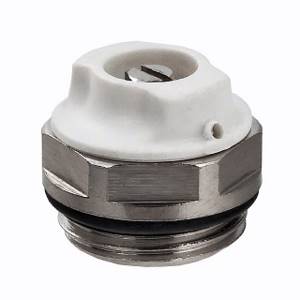
- Prepare a container (for example a bucket), a screwdriver and an adjustable wrench.

- Using an adjustable wrench, turn the plastic head of the valve so that the drain hole is in the lowest position.
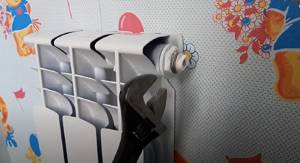
- A container is brought to the bottom of Mayevsky’s tap to collect water.
- The blade of the screwdriver is inserted into the slots of the screw and they begin to slowly turn it counterclockwise.
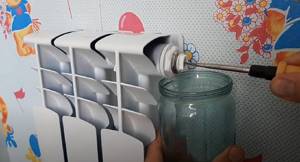
- First, you will hear the sound of air being released, then an intermittent stream of water will appear.
- You need to wait until the stream becomes continuous and flows evenly and silently.
- Stop removing water from the radiator by turning the screw back.
- For prevention, experts advise repeating the process after 1 – 2 hours.
Removing air using an automatic air vent
The device is often called a float because of the principle of its operation. The machine is installed in both a horizontal and vertical position.
When air masses accumulate, the float of the device floats up and puts pressure on the valve. In turn, the valve releases air, and the float returns to its original position.
Despite the convenience, it is necessary to periodically check the functionality of the diverter. The automatic device cannot withstand the presence of contaminants in the coolant. Therefore, they try not to install these devices in apartment buildings with centralized heating.
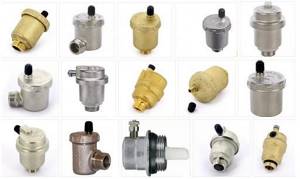
Bleeding air in old houses with cast iron radiators
In the past, cast iron batteries were equipped with ordinary water taps for venting. They were welded or screwed into the end caps of the upper collectors. The air was released by opening the tap. The process is almost similar to the method of bleeding air from a battery using a Mayevsky crane.
There are batteries without air vents . In this case, the air is released by unscrewing one of the upper plugs of the cast iron radiator with a wrench.
How to remove air from a battery under pressure without a Mayevsky tap. Do not repeat!
Bleeding air through thermostat
There are cases when the developer did not install a device for relieving air pockets on the radiators, and instead, thermostats were mounted on each battery. You can try to release the plugs by unscrewing the thermostat mounting nut.
However, you should remember that the sealing gasket can be damaged, replacing which will require draining the water from the entire system.
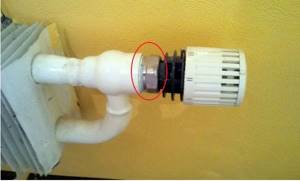
Specifications
Mayevsky taps with ¼, ½, ¾ inch threads are available for sale.
It is necessary to determine in advance the type of socket with which the radiators are equipped in order to determine the optimal size. For cast iron radiators, as well as welded pipe registers, you will have to additionally drill a hole in the side plug or directly in the pipe and cut the thread. Separately from the Mayevsky tap, ready-made plugs for standard cast iron radiators are sold. For ease of use, modern models of the Mayevsky tap are equipped with a handle with a side outlet.
A conventional valve with manual air release is usually installed in a horizontal position, an automatic air valve is installed strictly vertically, or is determined by the manufacturer in the case of a corner design.
How to ventilate batteries in a private home
The autonomous heating system of a private house differs significantly from a centralized heating network. The fact is that the owners of their houses turn to specialized enterprises for the installation of a heating system. Professionals use design documentation that provides for the installation of an expansion tank.

Ventilation system for autonomous heating communications of a private house
The tank is installed at a point that is higher than the entire heating system. Containers can be open or closed. In the first case, airing of the system is eliminated by simply adding coolant to the expansion tank. The closed tank is equipped with a release valve.
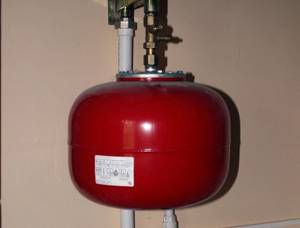
Closed expansion tank
The system is mounted in such a way that air pockets are squeezed out of the radiators and lifted into the expansion tank.
When the heating temperature of the coolant increases, the air collected in the tank leaves the container through the open valve.
Ventilation of the heating system of a private house.
Installation recommendations
Regardless of the type of automatic air intake for heating, you need to ensure that the exhaust cap faces up during installation. Bleed valves in systems are usually installed after ball valves or shut-off valves. An exception to the rule is the boiler safety group: secondary intermediate fittings are not used in this case.
Thanks to the shut-off check valve, it becomes possible to carry out maintenance or replacement of the air vent without emptying the entire heating system. Therefore, having such a device is very convenient. Only wrenches are suitable for installing an automatic bleeder: they, unlike adjustable ones, allow you to measure the effort required to screw the fastener. During installation work, it is not recommended to hold the device by the body to avoid damage. For these purposes, the design provides a hexagon at the bottom of the cylindrical chamber.
Preventing air locks
Prevention of airing of the heating system allows you to minimize the occurrence of such situations when you need to constantly remove air pockets from the heating system. To achieve this, the following preventive measures are carried out:
- installation of Mayevsky taps or automatic air vents on all batteries;
- Outside the heating season, you need to check that the radiators are hung correctly on the walls. If there are violations of the horizontality of the heating collectors, then you need to correct the position using shims for the brackets;
- in areas of the heating system with constant air pockets, float air release devices are installed;
- In autonomous heating systems of private houses, it is advisable to install water filters in them. Purified coolant will not cause air pockets in radiators.
Design and principle of operation
The design and principle of operation are almost completely described in the official name of the Mayevsky crane. This is a needle valve with a cone-shaped rod that closes the through channel in the device. Inside the valve there is a thin hole for bleeding air, which opens only if you start to unscrew the stem.
To open the air vent, you will need a special key or a regular slotted (flat-head) screwdriver. After completing a half or full rotation, a thin channel opens between the contents of the radiator or pipe and the external environment. Due to the high pressure inside the heating system, air and coolant are released outside, and not backwards. If air has accumulated at the installation site, it will come out first, followed by water.
The Mayevsky tap is made of corrosion-resistant brass, which ensures a long service life. Most often this is a plug made with a ½ or ¾ inch external thread, equipped with a needle valve.
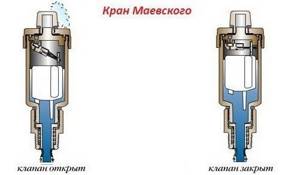
Automatic crane operating diagram
How to bleed air from old-style batteries
To this day, in the housing stock of Russia there are houses built a long time ago with batteries of the MS-140 model. In those days when these batteries were installed, they were equipped with ordinary water taps or simple bolts embedded in plugs with seals to bleed air.

The plugs are reset by simply opening these devices until a continuous stream of water appears without bubbles. If both devices are missing, remove the plugs by unscrewing the plugs, as described above.
How to bleed air from different types of batteries
Based on the material of manufacture, space heating devices are divided into a number of types of batteries with their own characteristics of air bleed - these are radiators:
- aluminum;
- steel;
- bimetallic;
- cast iron;
- copper;
Aluminum
Heating devices made of aluminum are made by extrusion of molten metal. That is, liquid aluminum is pressed into the flask. The material of the radiators is quite soft and deforms at the slightest mechanical impact. For this reason, aluminum batteries are recommended to be installed in private houses with autonomous heating systems equipped with automatic air vents.
Steel
Batteries made of steel are very durable. Therefore, they easily tolerate the installation of both Mayevsky cranes and automatic machines. Sometimes both are replaced with thermostats.
Bimetallic
Radiators that have a steel body covered with aluminum alloy fins are most often equipped with Mayevsky taps. Bimetallic devices are installed in private mansions and apartment buildings. Depending on local heating conditions, the radiators are equipped with automatic air discharge devices.
Cast iron
The peculiarities of cast iron, as a brittle material, force one to be careful when choosing devices for releasing air pockets. Basically, as mentioned above, conventional taps or mortise bolt valves are used.
Copper
This expensive, but excellent in its thermal conductivity, metal requires delicate handling. For copper radiators, special devices are used, built on the principle of the Mayevsky tap. The condition for inserting devices made of the same metal as the radiator itself is met - copper.
All these features of installing devices for bleeding air from batteries made of various materials do not depend on their design, whether they are sectional, tubular, panel, plate or vacuum devices.


